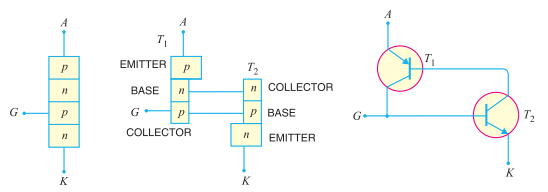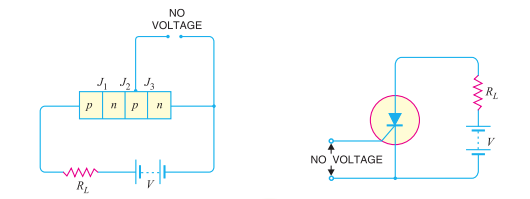
SCR VI Characteristics
Introduction:
In this article let’s see about SCR VI Characteristics. Before going to the VI characteristics of SCR, lets know about SCR & it’s Construction, working followed by its Applications.
Silicon Controlled Rectifier (SCR) or Thyristor:
Silicon Controlled Rectifier is a unidirectional semiconductor device made of silicon. This device is the solid state equivalent of thyratron and hence it is also referred to as thyristor or thyroid transistor.

What is a SCR?
SCR – Silicon Controlled Rectifier
- SCR – Silicon controlled rectifier is a semiconductor device that acts as a true electronic switch.
- A silicon controlled rectifier or semiconductor-controlled rectifier is a four-layer solid state current controlling device.
- It can change alternating current into direct current and at the same time can control the amount of power fed to the load. Thus, SCR combines the features of a rectifier and a transistor
- SCRs are mainly used in electronic devices that require control of high voltage and power. This makes them applicable in medium and also high AC power operations such as motor control function.
Construction of SCR:

- When a pn junction is added to a junction transistor, the resulting three pn junction device is called a silicon controlled rectifier. It is clear that it is essentially an ordinary rectifier (pn) and a junction transistor (npn) combined in one unit to form pnpn device.
- Three terminals are taken; one from the outer p-type material called anode A, second from the outer n-type material called cathode K and also the third from the base of transistor section and is called gate G. In the normal operating conditions of SCR, anode is held at high positive potential w.r.t. cathode and gate at small positive potential w.r.t. cathode.
SCR symbol:

Equivalent Circuit of SCR

SCR Working:
In a silicon controlled rectifier, load is connected in series with anode. The anode is always kept at positive potential w.r.t. cathode. The working of SCR can be studied under the following two heads
- When Gate is open
- When Gate is positive w.r.t. cathode.
Working of SCR :
- An SCR has two states i.e. either it does not conduct or it conducts heavily. There is no state In between. Therefore, SCR behaves like a switch.
- There are two ways to turn on the SCR. The first method is to keep the gate open and make the supply voltage equal to the breakover voltage. The second method is to operate SCR with supply voltage less than breakover voltage and then turn it on by means of a small voltage (typically 1.5 V,30 mA) applied to the gate.

- Applying small positive voltage to the gate is the normal way to close an SCR because the breakover voltage is usually much greater than supply voltage.

- To open the SCR (i.e. to make it non-conducting), reduce the supply voltage to zero
SCR characteristics:
A thyristor is a four layer 3 junction p-n-p-n semiconductor device consisting of at least three p-n junctions, functioning as an electrical switch for high power operations. It has three basic terminals, namely the anode, cathode and also the gate mounted on the semiconductor layers of the device. The basic circuit diagram for determining the characteristics of SCR is shown in the figure below.

VI Characteristics of SCR
It is the curve between anode-cathode voltage (V) and anode current (I). A V-I Characteristic of SCR is the voltage current characteristics. The current through the SCR varies as the Anode to Cathode terminal voltage and Gate to Cathode terminal voltage is varied.

Forward characteristics:
- When anode is positive w.r.t. cathode, the curve between V and I is called the forward characteristic. In Fig. 20.7, OABC is the forward characteristic of SCR at IG = 0.
- If the supply voltage is increased from zero, a point is reached (point A) when the SCR starts conducting. Under this condition, the voltage across SCR suddenly drops as shown by dotted curve AB and most of supply voltage appears across the load resistance RL.
- If proper gate current is made to flow, SCR can close at much smaller supply voltage.
Reverse characteristics.
- When anode is negative w.r.t. cathode, the curve between V and I is known as reverse characteristic. The reverse voltage does come across SCR when it is operated with a.c. supply.
- If the reverse voltage is gradually increased, at first the anode current remains small (i.e. leakage current) and at some reverse voltage, avalanche breakdown occurs and also the SCR starts conducting heavily in the reverse direction as shown by the curve DE.
- This maximum reverse voltage at which SCR starts conducting heavily is known as reverse breakdown voltage.
SCR VI Characteristics- Modes
SCR VI Characteristics have 3 modes of operation:
- Reverse blocking mode
- Forward blocking mode (off state)
- Forward conduction mode (on state)
Reverse Blocking Mode
When cathode of the thyristor is made positive with respect to anode with switch open thyristor is reverse biased. Junctions 𝐽1 and 𝐽2 are reverse biased where junction 𝐽2 is forward biased. The device behaves as if two diodes are connected in series with reverse voltage applied across them.
Forward Blocking Mode
When anode is positive with respect to cathode, with gate circuit open, thyristor is said to be forward biased. Thus junction 𝐽1 and 𝐽3 are forward biased and 𝐽2 is reverse biased. As the forward voltage is increases junction 𝐽2 will have an avalanche breakdown at a voltage called forward breakover voltage 𝑉𝐵𝑂. When forward voltage is less then 𝑉𝐵𝑂 thyristor offers high impedance. Thus a thyristor acts as an open switch in forward blocking mode.
Forward Conduction Mode
Here thyristor conducts current from anode to cathode with a very small voltage drop across it. So a thyristor can be brought from forward blocking mode to forward conducting mode:
- By exceeding the forward breakover voltage.
- By applying a gate pulse between gate and also cathode.
During forward conduction mode of operation thyristor is in on state and also behave like a close switch. Voltage drop is of the order of 1 to 2mV. This small voltage drop is due to ohmic drop across the four layers of the device.
Applications of SCR
- SCR as static contactor. An important application of SCR is for switching operations. As SCR has no moving parts, therefore, when it is used as a switch, it is often called a static contactor.
- SCR for power control. It is often necessary to control power delivered to some load such as the heating element of a furnace. Series resistances or potentiometers cannot be used because they waste power in high power circuits. Under such conditions, silicon controlled rectifiers are used which are capable of adjusting the transmitted power with little waste.
- SCRs for speed control of d.c. shunt motor
- Overlight detector
- SCR Crowbar. A crowbar is a circuit that is used to protect a voltage-sensitive load from excessive d.c. power supply output voltages.
SCR FAQ
What is SCR explain its IV characteristics?
Silicon Controlled Rectifier is a unidirectional semiconductor device made of silicon. VI Characteristics is the curve between anode-cathode voltage (V) and anode current (I). A V-I Characteristic of SCR is the voltage current characteristics. The current through the SCR varies as the Anode to Cathode terminal voltage and Gate to Cathode terminal voltage is varied.
What is SCR function?
A semiconductor device that functions as an electrically controlled switch.It can change alternating current into direct current and at the same time can control the amount of power fed to the load. Thus, SCR combines the features of a rectifier and also a transistor. SCRs are mainly used in electronic devices that require control of high voltage and power. This makes them applicable in medium and high AC power operations such as motor control function.
What are the 3 states of SCR?
The three states of SCR are
- Reverse blocking mode
- Forward blocking mode (off state)
- Forward conduction mode (on state)
Is SCR a 4 layer?
A silicon controlled rectifier or semiconductor-controlled rectifier is a four-layer solid state current controlling device
What is SCR used for?
SCRs are mainly used in devices where the control of high power, possibly at high voltage, is needed. SCRs are mainly used in electronic devices that require control of high voltage and also power. This makes them applicable in medium and high AC power operations such as motor control function.
What are VI characteristics of SCR?
V-I characteristics stand for voltage-current characteristics of SCR. Digital Voltmeter and Ammeters are provided to measure the voltage and current. A plot between Va and Ia is drawn by varying the source voltage E and noting the corresponding current through SCR.
LIKE WHAT YOU’RE READING?
CHECK OUT SOME OF OUR OTHER GREAT CONTENT HERE:
- STRAIN GAUGE WORKING PRINCIPLE
- LVDT- CONSTRUCTION, WORKING PRINCIPLE , APPLICATIONS, ADVANTAGES, AND DISADVANTAGES
- STEP UP TRANSFORMER: DEFINITION, CONSTRUCTION, WORKING & APPLICATIONS
- LIMITATIONS OF OHM’S LAW
- INDUCTION MOTOR: WORKING PRINCIPLE, TYPES & APPLICATION
- WORKING OF VACUUM CIRCUIT BREAKER
- WHAT IS OPERATING SYSTEM AND ITS TYPE
- TYPES OF LIGHTNING ARRESTER
- HOW DOES A CAPACITOR WORKS
- WHAT ARE THE USES OF CAPACITOR
- WHAT ARE THE APPLICATIONS OF OP AMP?
- HOW AN IGBT WORKS?
- VARIOUS USES OF A RESISTOR
- HOW THE MOSFET WORKS?
- POWER FACTOR IMPROVEMENT METHODS
- WORKING PRINCIPLE OF SYNCHRONOUS MOTOR
- SYNCHRONOUS MOTOR STARTING METHOD
- WHY THE SYNCHRONOUS MOTOR IS NOT SELF STARTING




5 Comments